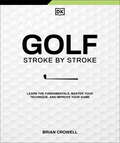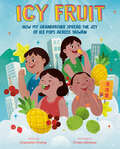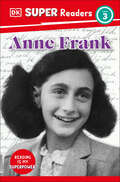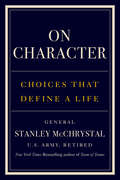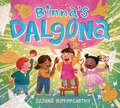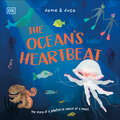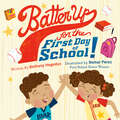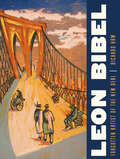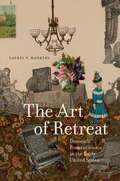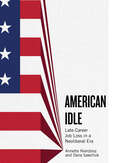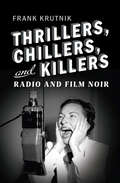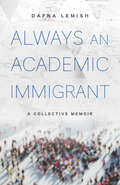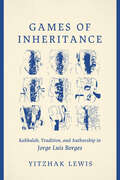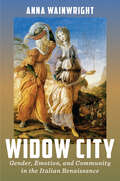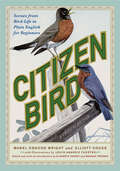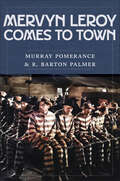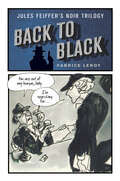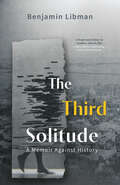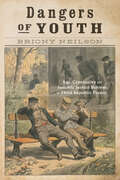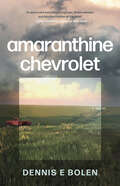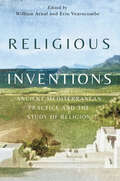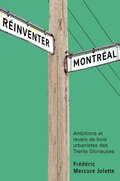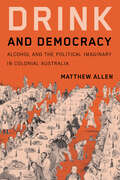- Table View
- List View
Golf Stroke by Stroke: Learn the Fundamentals, Master Your Technique, and Improve Your Game
by Brian CrowellLearn the game and perfect your technique with this guide to golf for beginnersGolf is a popular hobby sport, but if you've never picked up a club before, it's hard to know where to begin. Geared for the absolute beginner, Golf Stroke by Stroke is a comprehensive guide that covers everything you need to head to the golf course with confidence. From the clubhouse to the green, golf pro Brian Cowell will introduce you to each stage of the game and teach you how to swing a club through a series of simple lessons with full-color photos and baby-step-by-baby-step instructions. In addition, you'll get:Guidance on choosing the best clubs, balls, and gear for your needsHelpful golf pro advice on common mistakes and how to avoid themDozens of practice drills and "Picture This!" images to remind players of swing techniqueDetailed information on golf rules, lingo, and etiquette, including keeping score and calculating handicaps
Icy Fruit: How My Grandfather Spread the Joy of Ice Pops Across Taiwan
by Charlotte ChengThis fun and fascinating biography of a Taiwanese ice pop entrepreneur—the author's beloved grandfather—is a terrific read-aloud about inventiveness and the treats of summer.Charlotte Cheng's grandfather always had a bag of coins rustling in his pocket. That bag carried with it "a story of joyful jingles, sultry summers, and fresh frozen fruit which began in 1965 in the lush valleys and mountains of an island called Taiwan."This story of Agong's Icy Fruit company, from first inspired idea through experimentation to countrywide success, is a lyrical, lively, and richly illustrated read that's part biography, part family tribute, and part celebration of summer. Gather round for Icy Fruit!
DK Super Readers Level 3 Anne Frank (DK Super Readers)
by DKHelp your child power up their reading skills and learn all about the brave diarist, Anne Frank with this fun-filled nonfiction reader carefully leveled to help children progress.DK Super Readers Level 3: Anne Frank will help children learn all about the life of a young Jewish girl under Nazi occupation–using her own words preserved in her diary. It is a motivating introduction to using essential nonfiction reading skills, proving ideal for children ready to enter the riveting world of reading. DK Super Readers take children on a journey through the wonderful world of nonfiction: traveling back to the time of dinosaurs, learning more about animals, exploring natural wonders, and more, all while developing vital nonfiction reading skills and progressing from first words to reading confidently. The DK Super Readers series can help your child practice reading by:Covering engaging, motivating, curriculum-aligned topics.Building knowledge while progressing Grades 3 and 4 reading skills.Developing subject vocabulary on topics such as renowned young writer’s extraordinary life.Boosting understanding and retention through comprehension quizzes.Each title, which has been leveled using MetaMetrics®: The Lexile Framework for Reading, integrates science, geography, history, and nature topics so there’s something for all children’s interests. The books and online content perfectly supplement core literacy programs and are mapped to the Common Core Standards. Children will love powering up their nonfiction reading skills and becoming reading heroes. DK Super Readers Level 3 titles are visually engaging, full of fun facts about exciting topics, and motivate children to improve their nonfiction reading skills. They are perfect for children ages 8 to 10 (Grades 3 and 4) who are newly independent readers ready to advance.
On Character: Choices That Define a Life
by General Stanley McChrystalFrom the bestselling author of Team of Teams and My Share of the Task, reflections on character, and who we choose to be. &“Reputation is what men and women think of us; character is what God and angels know of us.&” —Thomas PaineHow to measure a life? After a career of service, retired four-star general Stanley McChrystal had much to contemplate. He pondered his successes and failures, his beliefs and aspirations, and asked himself, Who am I, really? And more importantly, who have I become? When I die, how will I be measured?In the end, McChrystal came to a conclusion as simple as it was profound: the reality of who we are cannot be recorded in dates or accomplishments. It is found in our character—the most accurate, and last full measure, of who we choose to be.On Character offers McChrystal&’s blueprint for living with purpose and integrity, challenging us to examine not just our deeds but who we become through them. Drawing from a lifetime of experience, he distills profound insights on setting and meeting standards, aligning actions with beliefs, and offers practical advice on overcoming obstacles and pursuing self-improvement.According to McChrystal, character is not a trait inherited at birth, nor does it automatically come from education, position, or experience. Character, instead, comes down to a succession of choices, most mundane, several momentous, that reveal the deep truth of our capacity for virtue.In an era where understanding and upholding our ideals is more crucial than ever, On Character offers an inspiring roadmap for personal growth and integrity—a call to become our best selves, both as individuals and as Americans.
Binna's Dalgona
by Sojung Kim-McCarthyBinna introduces her friends to a sweet Korean treat in this charming picture book about finding the right words in a new languageBinna&’s finally starting to feel like she&’s not a baby—she can read long books in English, beat her older sister at word games, and she can make dalgona by herself. But when she tries to tell her classmates about her weekend and the sugary, sandy treat she made . . . well, the English doesn&’t come to her easily. Not being able to say what she wants is crushing. But with her sister's encouragement and the support of her classmates, Binna finds the right words (and snack) to share about her life in Korea.
DK Super Readers Level 3 Helen Keller (DK Super Readers)
by DKHelp your child power up their reading skills and learn all about the life of Helen Keller with this fun-filled nonfiction reader carefully leveled to help children progress.DK Super Readers Level 3: Helen Keller offers a sensitive account of the life of a young girl unable to see and hear who grew into an extraordinary scholar, public speaker, activist, and role model. It is a motivating introduction to using essential nonfiction reading skills, proving ideal for children ready to enter the riveting world of reading. DK Super Readers take children on a journey through the wonderful world of nonfiction: traveling back to the time of dinosaurs, learning more about animals, exploring natural wonders, and more, all while developing vital nonfiction reading skills and progressing from first words to reading confidently. The DK Super Readers series can help your child practice reading by:Covering engaging, motivating, curriculum-aligned topics.Building knowledge while progressing Grades 3 and 4 reading skills.Developing subject vocabulary on topics such as this courageous young woman’s success in the face of many challenges –and the people who supported her.Boosting understanding and retention through comprehension quizzes.Each title, which has been leveled using MetaMetrics®: The Lexile Framework for Reading, integrates science, geography, history, and nature topics so there’s something for all children’s interests. The books and online content perfectly supplement core literacy programs and are mapped to the Common Core Standards. Children will love powering up their nonfiction reading skills and becoming reading heroes. DK Super Readers Level 3 titles are visually engaging, full of fun facts about exciting topics, and motivate children to improve their nonfiction reading skills. They are perfect for children ages 8 to 10 (Grades 3 and 4) who are newly independent readers ready to advance.
The Ocean's Heartbeat: The Story of a Jellyfish in Search of a Heart
by Dame & DusaThis picture book for young children is about the beauty of every heart and celebrating your own uniqueness.The Ocean’s Heartbeat is a joyous, read-aloud picture book about the uniqueness of every creature's heart for children aged 3-5. Packed with fascinating scientific knowledge, including extra pages about the unique hearts of more amazing creatures, this engaging book shows the incredible diversity of life on Earth and encourages everyone to love how they are different and to celebrate being themselves. This magical picture book for children offers: A whimsical and entertaining narrative that can be shared between parents/caregivers and children.Beautiful, atmospheric collage-style artwork that captures the magic of the jellyfish's journey to find a mysterious heartbeat.An important story that celebrates the diversity of living creatures and encourages children to value their own uniqueness.In the depths of the sea, a jellyfish hears a loud THOOMP. What is this mysterious sound? A wise fish explains that the THOOMP is a heartbeat. The jellyfish listens to the wise fish's soft heartbeat but sadly realizes she has no heartbeat herself, so she swims off to search for it. Along the way, she meets various creatures and learns about their heartbeats, from the seal to the whale to the octopus with three hearts! But why can't she hear her own?
Batter Up for the First Day of School!
by Bethany HegedusA playful, baseball-themed first-day-of-school adventure!Wake up, Sluggers. It&’s time to . . .Batter up for the first day of school!It&’s the first day of school at Grand Slam Elementary, and there is much to do before the Twins can step up to the plate! After putting on their uniforms, fueling up for the day, and doing an equipment check, the kids are ready to slide into first period. Opening day is full of curveballs, but the innings fly by until the kids return to home base, excited to do it all again tomorrow!With plenty of punny prose and playful baseball terms, this humorous read-aloud is the perfect way to get little sluggers ready for the first day of school.
Leon Bibel: Forgotten Artist of the New Deal
by Richard HawLeon Bibel (1913–1995) was a prolific modern American artist who painted, printed, stamped, etched, sketched, and carved. He produced pieces that ranged from social realism to dreamy expressionism and was an aesthetic experimentalist, never working for too long in any medium or style. And despite Bibel's obvious talent, his work would have languished in obscurity were it not for the New Deal programs like the Federal Art Project and Public Works of Art Project. Leon Bibel, the first biography of this eclectic artist, recounts his life from his birth in Szczebrzeszyn, Poland, in 1913, to his death in New Jersey in 1995. After immigrating to the United States in the 1920s, Bibel came of age during the Great Depression, when New Deal agencies recognized his abilities and supported his artistic endeavors. Working-class artists faced challenges after these programs folded, and Bibel would later spend twenty years as a New Jersey chicken farmer before resurrecting his art career in the 1960s. Historian Richard Haw shows how Bibel's life was defined by the New Deal, his visionary artwork shaped by the era's commitment to social and economic justice. With reproductions of more than 240 of Bibel's works, most in vivid color, this book reveals how he depicted everything from the trauma of unemployment to the dignity of work, from the horrors of lynching to the pleasures of everyday life.
The Art of Retreat: Domestic Romanticisms in the Early United States (Transits: Literature, Thought & Culture, 1650-1850)
by Laurel V. HankinsThe political and cultural fantasy of home as a retreat from the pressures of the world first emerged in the U.S. alongside two major nineteenth-century literary movements: Romanticism and domestic fiction. Upending accepted gendered narratives from this period, The Art of Retreat posits that these movements originated from a domestic culture already in transition, in which home was frequently a more complicated site of self-interested pleasure, coerced labor, creole social reproduction, homosocial intimacy, bachelor whimsy, petty tyranny, racial abuse, and transgender capacity. The early national periodicals, sketches, and novels examined here lend themselves to this interpretation. Hankins argues that the literary tradition emerging from these decades—one that aligned creative genius with domestic retreat—reminds us that a politics that appeals to private feeling must reckon with new interpretations of labor, kinship, and reform in exchange for the promise of consensual citizenship. Published by Bucknell University Press. Distributed worldwide by Rutgers University Press.
American Idle: Late-Career Job Loss in a Neoliberal Era (Inequality at Work: Perspectives on Race, Gender, Class, and Labor)
by Annette Nierobisz Dana Sawchuk Dana Sawchuck Annette Marie NierobiszIn American Idle, sociologists Annette Nierobisz and Dana Sawchuk report their findings from interviews with sixty-two mostly white-collar workers who experienced late-career job loss in the wake of the Great Recession. Without the benefits of planned retirement or time horizons favorable to recouping their losses, these employees experience an array of outcomes, from hard falls to soft landings. Notably, the authors find that when reflecting on the effects of job loss, fruitless job searches, and the overall experience of unemployment, participants regularly called on the frameworks instilled by neoliberalism. Invoking neoliberal rhetoric, these older Americans deferred to businesses’ need to prioritize bottom lines, accepted the shift toward precarious employment, or highlighted the importance of taking initiative and maintaining a positive mindset in the face of structural obstacles. Even so, participants also recognized the incompatibility between neoliberalism’s “one-size-fits-all” solutions and their own situations; this disconnect led them to consider their experiences through competing frameworks and to voice resistance to aspects of neoliberal capitalism. Employing a life course sociology perspective to explore older workers’ precarity in an age of rising economic insecurity, Nierobisz and Sawchuk shed light on a new wrinkle in American aging.
Thrillers, Chillers, and Killers: Radio and Film Noir
by Frank KrutnikFilm noir is one of the most exciting and most debated products of studio-era Hollywood, but did you know that American radio broadcast many programs in the noir vein through the 1940s and 1950s? These included adaptations of such well-known films as The Maltese Falcon, Murder, My Sweet, and Double Indemnity, detective series devoted to the adventures of private eyes Philip Marlowe and Sam Spade, and the spine-tingling anthology programs Lights Out and Suspense. Thrillers, Chillers, and Killers is the first book to explore in detail noir storytelling on the two media, arguing that radio’s noir dramas played an important role as a counterpart to, influence on, or a spin-off from the noir films. Besides shedding new light on long-neglected radio dramas, and a medium that was cinema’s major rival, this scrupulously researched yet accessible study also uses these programs to challenge conventional understandings of the much-debated topic of noir.
Always an Academic Immigrant: A Collective Memoir
by Dafna LemishImmigrant employees play an essential role in every industry, including academia, but the unique experiences of immigrant professors have received little study. Given that academia has its own distinctive cultural norms, do immigrant academics experience the same kinds of challenges endured by other immigrants? Always an Academic Immigrant is a collective memoir that gives voice to eighty-one academics who immigrated from thirty-seven countries for a career in an institution of higher education, in either the United States or one of ten other countries. Through in-depth interviews and observations from her own experiences as an immigrant scholar, Dafna Lemish shares the highs and the lows that academic immigrants feel as they search for both a country and an institution they can call home. She discovers the formative events that led these scholars to pursue careers outside their native lands and details the challenges they faced adapting to unspoken expectations in their new countries and workplaces. Ultimately, this book reveals the strategies that immigrant professors use to bridge their native and adoptive cultures while highlighting the vital contributions they have made to academia as scholars, teachers, and leaders.
Games of Inheritance: Kabbalah, Tradition, and Authorship in Jorge Luis Borges
by Yitzhak LewisGames of Inheritance explores the thought of Argentine author and public intellectual Jorge Luis Borges (1899–1986) on questions of authorship and literary tradition. The book focuses on Borges’s engagement with Jewish literary and intellectual traditions, highlighting the role of this engagement in developing and expressing his views on these questions. The book argues that the primary relevance of Borges’s persistent reference to “the Judaic” is not for understanding his attitude toward Jews and Judaism but for understanding his position in contemporary Argentinian debates about nationalism and literature, empire and postcolonialism, and populism and aesthetics. By broadening the frame of Borges and the Judaic, this book shifts the scholarly focus to the poetic utility of Borges’s engagement with Jewish literary and intellectual traditions. This allows a better understanding of the nuance of his views on the issues that most animate his oeuvre: authorship and writing, literature and tradition.
Widow City: Gender, Emotion, and Community in the Italian Renaissance (The Early Modern Exchange)
by Anna WainwrightWidow City: Gender, Emotion, and Community in Renaissance Italy investigates the ever-evolving role of the widow in medieval and early modern Italian literature, from canonical authors such as Dante, Petrarch, and Boccaccio, to the numerous widowed writers who rose to prominence in the sixteenth century—including Vittoria Colonna, Veronica Gambara, and Francesca Turina—and radically changed the conversation on public mourning. Engaging with broader intellectual discussions around gender, the history of emotions, the politics of mourning, and the construction of community, Widow City argues that widows served as key models demonstrating to readers not just how to mourn, but how to live well after devastating loss. At the same time, widows were figures of great anxiety: their status as unattached women, and the public performance of their grief, were viewed as very real threats to the stability of the social order. They are thus key to broader intellectual understandings of community and civic life in the Italian Middle Ages and Renaissance.
Citizen Bird: Scenes from Bird-Life in Plain English for Beginners, A Critical Edition
by Mabel Osgood Wright Elliott Coues Elliot CouesIn the late nineteenth century, American bird lovers faced a crisis. Bird species were becoming endangered or even extinct at an alarming rate, and old methods of hunting and collecting specimens accelerated the process. A new conservationist approach to birding was necessary, and it needed to be taught to the next generation of Americans. Thus 1897’s Citizen Bird, the first birding guide for children, was born. A tremendously influential text in the Progressive-era United States, it inspired in a generation of schoolchildren a love of wild birds and the desire to protect them. Born of a collaboration between naturalist Mabel Osgood Wright, ornithologist Elliott Coues, and bird artist Louis Agassiz Fuertes, the book is vital to the history of birding and the broader study of nineteenth-century American culture and literature. This new edition of Citizen Bird preserves the original book’s 111 drawings and adds explanatory footnotes, supplemental historical material, and a new introduction. More than a century and a quarter after its original publication, Elizabeth Cherry and Meghan Freeman contextualize the book in the tradition and history of birding and discuss the roles of its authors and illustrator in birding history. A landmark text in the history of American conservationism, Citizen Bird is a timeless classic that will bring joy to birdwatchers of all ages.
Mervyn LeRoy Comes to Town
by Matthew Solomon David Desser Linda Badley Kristen Hatch Neil Badmington Matthew H. Bernstein Steven Rybin Mark Osteen Lawrence Napper R. Barton Palmer Adrian Danks Rebecca Bell-Metereau Brenda Austin-Smith Dominic Lennard Daniel Varndell Matthew Cipa Murray Pomerance Tom ConleyMervyn LeRoy Comes to Town is the first book devoted to the career of one of the director/producers who in the early years of sound cinema was instrumental in establishing the Hollywood model of production that would endure for more than half a century. As a director and producer, LeRoy was responsible for turning out more than sixty feature films in a career that spanned five decades; as a studio executive, he contributed substantially to the success of the industry during the challenging period of the Depression and also in the period of realignment and readjustment that followed the end of World War II. This book offers chapters devoted to individual films such as Little Caesar, Waterloo Bridge, 30 Seconds over Tokyo, Gypsy, and Quo Vadis.
Back to Black: Jules Feiffer’s Noir Trilogy (Critical Graphics)
by Fabrice LeroyThe legendary American cartoonist and author Jules Feiffer has enjoyed a long and varied career, working on everything from illustrating The Phantom Tollbooth to writing the screenplay for the film Popeye. But some of his most innovative work came very late in his career, with a trio of graphic novels he composed in his eighties: Kill My Mother (2014), Cousin Joseph (2016), and The Ghost Script (2018). Back to Black provides the first full-length critical analysis of this trilogy, exploring how it pays homage to the iconography and themes of film noir through constant graphic experimentation and a striking reinvention of Feiffer’s distinctive style. Fabrice Leroy shows how Feiffer deftly alternates between dramatic and satirical tones as he plays with the conventions of noir to provide a caustic yet moving commentary on mid-twentieth-century American life. Through close readings of each novel in the trilogy, he examines Feiffer’s singular depiction of the central political issues in the United States from the Great Depression to the 1950s, which still resonate today: unionization struggles, cinematic propaganda, McCarthyism, the American Dream, immigration, antisemitism, civil rights, and gender discrimination. Placing the noir trilogy into the context of Feiffer’s long career, Back to Black demonstrates how he offers a loving pastiche of the genre without losing his unique voice or critical edge.
The Third Solitude: A Memoir Against History
by Benjamin Libman“A frank love letter to modern Jewish life.” — MERVE EMRE, contributing writer, The New YorkerAn intimate memoir in essays seeking familial history and personal memory against the backdrop of the lost world of North American Jewry.What is the past? How can we let it speak on its own terms, without forcing it into the categories of history? In The Third Solitude, Benjamin Libman gathers and weaves the threads of multiple pasts — of his community, of his family, and of himself — in an attempt to escape the inadequate narratives around Zionism that he grew up with, and to create nothing short of a new paradigm. Across a series of interconnected memories, Libman leads us through the many fragments that make a life, unafraid to question deeply cherished beliefs about Jewish identity, and seeks to reconcile his own values with those inculcated in him. Along the way, he casts aside tired tropes and shores together the pieces of a new way of looking toward the future. The Third Solitude is a paean to the art of losing, and to the visions of the past that persist in the present..
Dangers of Youth: Age, Criminality, and Juvenile Justice Reform in Third Republic France (States, People, and the History of Social Change)
by Briony NeilsonFrench society at the turn of the twentieth century was deeply preoccupied with the conduct and management of its young people, especially those who had broken the law. Legislators and social reformers of the Third Republic grappled with the question of whether children who committed offences should be held criminally responsible for their actions or if their age should exempt them from liability.Dangers of Youth examines foundational debates – about young lawbreakers, their criminal liability, and their appropriate treatment – at the origins of France’s modern juvenile justice system. In a context of overcrowded prisons, frequent recidivism, a sluggish birth rate, and growing international tension, young offenders were viewed as harbingers of the nation’s decline and as dangerous agents of disorder. At the same time, young people, including juvenile delinquents, were seen as victims of neglect and necessary vehicles for national regeneration. In 1912 legislators established a distinct criminal justice system for juveniles, enshrining probation at its heart and decriminalizing offences committed by children under the age of thirteen. Legislators drew on recommendations from France’s pre-eminent penal reform association, the Société générale des prisons, introducing measures that enabled the state to intervene as never before in children’s upbringing.Dangers of Youth is a detailed historical account of the emergence of greater age consciousness in the criminal justice system in modern France, which contributed to the creation of a distinct branch of justice for juveniles.
Amaranthine Chevrolet
by Dennis E. BolenA teenage boy’s curious road trip across a radically changing country.In the year 1967, fifteen-year-old Robin drives an antique pickup truck west from Saskatchewan, travelling on farmland and on unmapped roads to avoid police. Like Odysseus striving toward home, he encounters trying situations: men on the run, hippies creating utopia, marijuana farmers, mechanical breakdowns, a raging forest fire. Robin passes through a massively changing society — a rural culture that, though eroding, hangs on to values of kindness and endurance, and one in which Robin must be both heroic and vulnerable.A RARE MACHINES BOOK
Religious Inventions: Ancient Mediterranean Practice and the Study of Religion (Studies in Christianity and Judaism)
by William Arnal, Erin K. VearncombeReligion is a modern invention, a category used to describe and study certain kinds of human behaviour. Yet when it comes to the ancient world and its texts – including those that comprise the Jewish and Christian Bibles – it can be easy to forget that they did not fall from the sky as simple expressions of dogma. Rather, the ancient writings of early Judaism and Christianity are firmly rooted in the world and are the product of an astonishing array of human experience and agency: acts of self-fashioning; of imaginative speculation; of mourning and memorializing; of forming, dissolving, or refashioning group identities; and more.Religious Inventions asks how modern conceptions of religion can shed light on the relics, textual and otherwise, of ancient Mediterranean Jews and Christians. What insights from the contemporary study of religious behaviours and practices challenge what we think we know about the ancient world? Conversely, how can thinking about the ancient world challenge what we think we know about religion today? This volume responds to these questions through explorations of the material and social circumstances behind the production of written artifacts. It examines how religious practices relate to conceptions of identity and critiques the utility of the comparative method for approaching ancient writings.Textual authority is used and abused by many of today’s public figures. Religious Inventions offers an alternative approach to understanding how authority is constructed: from the ground up, by the creative actions and choices of real people who lived long ago.
Réinventer Montréal: Ambitions et revers de trois urbanistes des Trente Glorieuses (Studies on the History of Quebec/Études d'histoire du Québec)
by Frédéric Mercure JolettePlusieurs estiment que le développement problématique des villes durant les Trente Glorieuses fut le résultat des idées des urbanistes modernistes. Réinventer Montréal considère qu’il est temps de revoir ce récit historique qui dépeint les urbanistes du passé en vilains technocrates pro-croissance en revisitant l’héritage des plans modernistes d’après-guerre.Frédéric Mercure Jolette retrace les idées et les actions de trois urbanistes ayant œuvré à repenser le développement de Montréal dans les années 1960, soit Hans Blumenfeld, Jean-Claude La Haye et Claude Robillard. À partir d’un examen de leurs archives personnelles et des plans et des documents d’urbanisme qu’ils ont réalisés, l’ouvrage met en lumière la nature de l’expertise qu’ils prétendent construire et la manière dont ils s’en revendiquent. Réinventer Montréal reconstruit la logique interne, les projets, les hésitations, les contrariétés et les débats – notamment avec Jane Jacobs et les partisans du tournant participatif – qui ponctuent leur parcours intellectuel respectifs et, parallèlement, l’ouvrage forge une interprétation plus générale du destin de l’urbanisme moderniste.Contre l’interprétation dominante selon laquelle l’urbanisme des Trente Glorieuses serait démesurément technophile et ferait taire les débats, la croissance et le progrès technique se présentent dans Réinventer Montréal à la fois comme des menaces qui risquent de déstructurer la ville et comme des occasions permettant de mettre en place un réaménagement harmonieux, réaménagement qui ouvre à d’intarissables débats.
Drink and Democracy: Alcohol and the Political Imaginary in Colonial Australia (Intoxicating Histories)
by Matthew AllenThe nineteenth-century spread of democracy in Britain and its colonies coincided with an increase in alcohol consumption and in celebratory public dinners with rounds of toasts. British colonists raised their glasses to salute the Crown in rituals that asserted fraternal equality and political authority. Yet these ceremonies were reserved for gentlemen, leaving others – notably women and Indigenous people – on the political margins.Drink and Democracy traces the development of democratic ideas in New South Wales through the history of public drinking and temperance. As the colony transformed from a convict autocracy to a liberal democracy, Matthew Allen argues, public drinking practices shaped the character of the emerging political order. The ritual of toasting was a symbolic display of restraint – drunkenness without loss of self-control – that embodied the claim to citizenship of white male settlers. Yet the performative sobriety of the temperance movement was also democratic, a display of respectability that politicized its supporters around a rival vision of responsible citizenship. Drink was a way to police the limits of the political realm. The stigma of female drunkenness worked to exclude women from the public sphere, while perceptions of heavy drinking among Aboriginal people cast them as lacking self-control and hence unworthy of political rights.Drink and Democracy reveals that long before the introduction of the franchise, colonists in Australia imagined themselves as citizens. Yet even as democracy expanded, drink marked its limits.
The Abyss Stares Back: Encounters with Deep-Sea Life (Posthumanities #72)
by Stacy AlaimoIn an era of accelerating extinctions, what does it mean to discover thousands of new species in the deep sea? As we see the catastrophic effects of the Anthropocene proliferate, advanced technologies also grant us greater access to the furthest reaches of the world&’s oceans, facilitating the discovery of countless new species. Sorting through the implications of this strange paradox, Stacy Alaimo explores the influence this newfound intimacy with the deep sea might have on our broader relationship to the nonhuman world. While many images of these abyssal creatures circulate as shallow clickbait, aesthetic representations can be enticing lures for speculating about their lives, profoundly expanding our environmental concern. The Abyss Stares Back analyzes a diverse range of scientific, literary, and artistic accounts of deep-sea exploration, including work from the naturalist William Beebe and the artist Else Bostelmann as well as results of the Census of Marine Life that began at the turn of the twenty-first century. As she focuses on oft-overlooked creatures of the deep, such as tubeworms, hatchetfish, siphonophores, and cephalopods, which are typically cast as &“alien,&” Alaimo shows how depictions of the deep seas have been enmeshed in long colonial histories and racist constructions of a threatening abyss. Drawing on feminist environmentalism, posthumanism, science and technology studies, and Indigenous and non-Western perspectives, Alaimo details how our understanding of science is fundamentally altered by aesthetic encounters with these otherworldly life forms. She argues that, although the deep sea is often thought of as a lifeless void with little connection to human existence, our increasing devastation of this realm underscores our ethical obligation to protect the biodiverse life in the depths. When the abyss stares back, it demands recognition. Retail e-book files for this title are screen-reader friendly with images accompanied by short alt text and/or extended descriptions.
